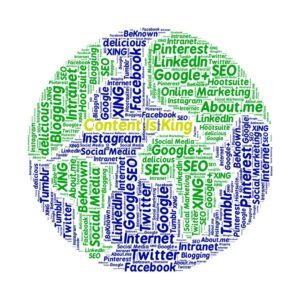
Everyone knows content and everyone can do it – no way! To avoid failures in the future, I have summarized the seven most common mistakes of content marketing for your company. Read it now!
Good content marketing is based on heart and soul, time and a sophisticated strategy – that’s the theory. In practice, however, not everything always goes smoothly. Far too often, problems stand between you and successful content marketing. Read about the seven mistakes you should avoid at all costs – and how to do it better – here.
Mistakes of content marketing: Identifying and eliminating potential stumbling blocks
In a time when digital media rule the world, sophisticated content marketing is elementary for businesses. After all, you want your content to be visible on the web, reach your target audience, and inspire them – because your content is unique, fully engages users, and benefits them to boot. But stumbling blocks and misunderstandings can quickly throw you off balance on the winning track – and can diminish your success. Clear the obstacles out of the way once and for all! After this article, they won’t happen to you anymore – because then you’ll know the seven most common mistakes of content marketing.
1️⃣. Mistake: you don’t define your goals and target audience
One of the main reasons why your content marketing backfires: you have no idea of what and who you want to reach with your content. You need a BHAG, a vision and of course goals! You define these using the SMART method, for example:
- S-specific: formulate your goals clearly and precisely.
- M-measurable: Define your goals in measurable parameters. This is the only way to compare the initial situation and the final state.
- A-acceptable/A-attractive: Find goals that everyone involved in content marketing can identify with.
- R-realistic: Stay grounded, don’t set your goals too high.
- T-terminable: set a time frame/date within which/by when you want your goals to be achieved.
Now you know what your content goals are, but not who you want it to reach. Your content can be as good as it is – if it doesn’t land with your target audience, it’s worthless. Only if you know who your customers are can you target them. With the help of personas, you give users a face and get to know them and their needs better.
2️⃣. Mistake: You just write away
Your head is full of ideas and you’d like to hit the keys right away? Calm down! Take it a little easier – after all, good things come to those who wait. Even if you already know your target group and know how to address them specifically – with the masses of content on the Word Wide Web, your aim should be to stand out with unique content.
You can achieve this with high-quality content that is thoroughly researched. If you work accurately, identify and address current topics, and back up your statements with sources, you are well on your way to winning the trust of users – and generating more clicks in the long term.
3️⃣. Mistake: You only think about onpage SEO, or not at all.
Content marketing without SEO is like white sausage without sweet mustard – bland, incomplete and pointless. Because both disciplines enter into a perfect symbiosis and benefit from their community: Google needs content, content marketing delivers it. And without content, there is no search engine optimization. This fact gives us the insight that content marketing is part of digital marketing.
The ideal SEO text contains, among other things, one or more carefully researched keywords that are
- in the Google snippet
- in the main headline (H1), the sub-headlines (H2, H3)
- and repeatedly scattered throughout the body text.
However, you should not overdo it with the amount of keywords: On the one hand, keyword stuffing causes the quality of your content to be lost. On the other hand, such content is classified as spam by Google – whereupon the search engine penalizes your website through poor ranking.
4️⃣. Mistake: You don’t tell stories
Hand on heart: Do you like reading texts in which the advertising message jumps out at you in almost every line? Probably not – and neither do your readers. To keep them interested, you’d better follow the motto: Great content needs storytelling – and beats advertising blah-blah! The more informative and entertaining the content, the more interesting it is for the user. Emotional stories also get to the heart – and as soon as emotions are involved, the purchase decision is usually only a few clicks away.
5️⃣. Mistake: you don’t use (appealing) images
Good content that offers added value is the be-all and end-all in content marketing for companies. However, even the best text comes around the corner naked without supporting images. Appeal to your readers visually, too! Images are eye-catchers and often say more than a thousand words.
Choose high-contrast, eye-catching, and meaningful photos, especially when it comes to article and teaser images that complement your headline. Your photos should also whet the appetite for the text and help determine whether or not the user continues reading. When selecting images, be sure to pay attention to usage rights. Anyone who (unintentionally) steals photos is liable to prosecution! And do not forget: Include the keyword in the caption and in the alt tag!
6️⃣. Mistake: You forget the call-to-action(s).
Whether it’s ad copy, tweets, or blog articles like this one, they all need a call-to-action directed at the user. That’s because with almost every type of communication, you’re pursuing a goal: you want to trigger a specific action and thus generate conversions. For example, you want to
- Encourage users to read,
- attract newsletter subscribers
- or persuade potential customers to buy your product/service (keyword: conversion).
To ensure that the user does not get lost or even turn back on his virtual journey through your website (customer journey), you use call-to-actions to guide him all the way to the decision to act. In concrete terms, this means that you take them by the hand and tell them what they should do next.
Here are a few tips on how to formulate a click-worthy call-to-action:
- Use active verbs in the imperative without making your call-to-action sound like a command. For example, “Call right away and schedule a desired appointment” or “Read now and learn more.”
- Make it clear where clicking the CTA button will lead and what benefit the user will get from it. “Click here” is too vague.
- “Order now” is more specific – and also conveys a sense of urgency through the “now”. Other examples of how to make your call to action more emphatic: “Buy today only at a special price” or “Sign up now and secure a discount”.
7️⃣. Mistake: Leaving content to its fate
Your content has been created, gone online along with images, videos and/or infographics – job done, sit back. If you think like this, you might as well throw your campaign in the garbage can. Because this way, you’ll never find out if your work is crowned with success.
So get to work: measure and analyze which content and which forms are best received by the target group. To do this, check the bounce rate and click rate of your articles, among other things. Is there still room for improvement? Then revise and optimize your texts until the numbers increase.
It’s also not enough if the content is only on your homepage. Keyword: social media. Spread the word! Share and distribute your content in all networks where your target group is on the move. If hardly anyone takes notice at first, promote your content additionally via paid social ads. That way, the longed-for traffic won’t be long in coming.
Everything clear so far? Good, because now it’s your turn! Clear away all the stumbling blocks that get in your way on your way to becoming a content professional. Avoid these seven content marketing mistakes and achieve your company’s goals with unique content. Go for it – you can do it!
